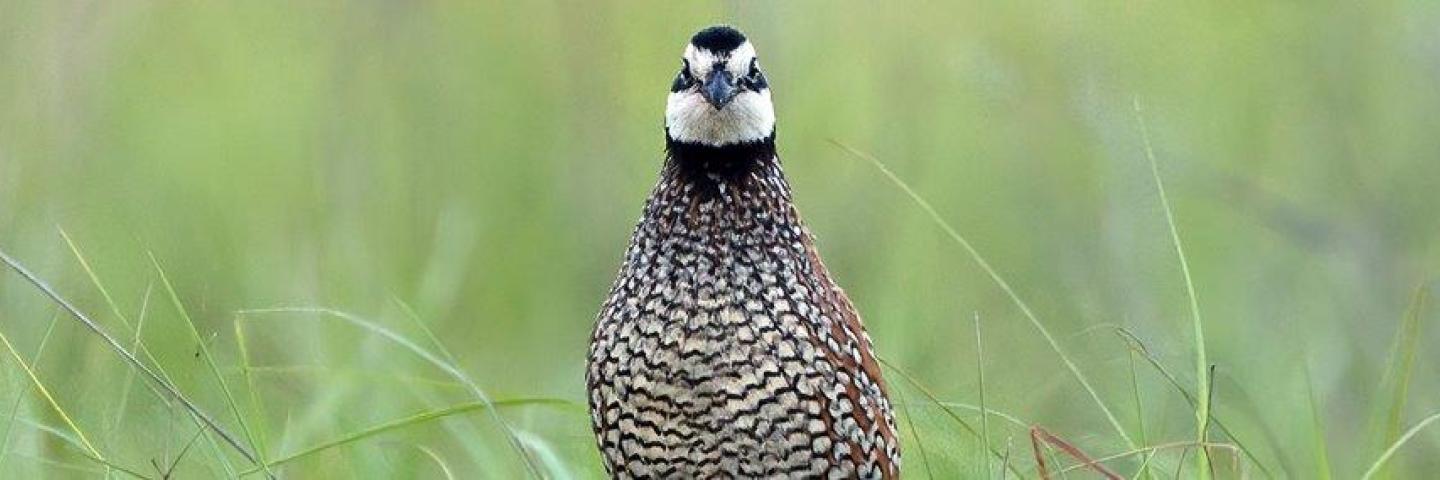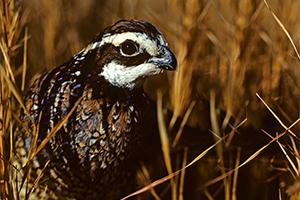
The northern bobwhite (Colinus virginianus) is often referred to as an “edge” species, seeking habitat where crop fields intersect with woodlands, pastures and old fields.

Latest News
New Northern Bobwhite Pilot Project Available in 18 States: This new pilot project, which is part of Working Lands for Wildlife (WLFW), offers agricultural producers and landowners the tools to conserve wildlife habitat for northern bobwhite quail by improving East-Central grasslands while achieving other critical conservation benefits, including sequestering carbon and improving water quality and soil health.
Through this new pilot, NRCS offers financial and technical assistance to producers in Alabama, Arkansas, Florida, Georgia, Illinois, Iowa, Kansas, Minnesota, Mississippi, Missouri, Nebraska, Ohio, Oklahoma, South Carolina, Tennessee, Texas, Virginia and West Virginia to help the bobwhite and other game and non-game species by managing their working lands for early successional habitat while meeting their lands natural resource and production goals. Learn more about the project.
NRCS accepts applications year-round for this pilot project through the Environmental Quality Incentives Program (EQIP). Interested producers from eligible states should contact NRCS at their local USDA Service Center.
The northern bobwhite (Colinus virginianus) is an iconic species in rural America that has supported a rich hunting tradition for generations. Scientific research has shown that what is good for the bobwhite also benefits many other wildlife species, and native habitat, which supports pollinators, as well.
Historically, land use favored bobwhite, but changes in how agricultural lands are managed, plus increased development has caused bobwhite numbers to dip by more than 80 percent, over the last 60 years. This decline is similar to that seen in native grasslands and savannas across the bird’s range, and habitat loss and degradation is the primary threat to bobwhite populations.
Bobwhites depend on early successional habitat grasslands, shrubby areas, and pine or oak savannahs found across the East. These habitats have the forbs, legumes and insects that bobwhite need for food and the heavy or brushy cover for nesting, brooding and safety. To help reverse bobwhite declines, NRCS is working with private landowners to manage their land for high-quality habitat in grasslands and pine savannas.
Landowners in Alabama, Arkansas, Delaware, Florida, Georgia, Illinois, Indiana, Iowa, Kansas, Kentucky, Louisiana, Maryland, Minnesota, Mississippi, Missouri, Nebraska, New Jersey, North Carolina, Ohio, Oklahoma, South Carolina, Tennessee, Texas, Virginia, and West Virginia are helping the bobwhite by managing for habitat on working lands. With the help of NRCS, landowners are making wildlife improvements to working lands, such as establishing field borders and buffer strips, integrating native plants into conservation cover and pasture plantings, and thinning forests through brush management and prescribed fire to invigorate ground cover vegetation.
NRCS offers technical and financial assistance to help landowners manage for early successional habitat. This assistance helps producers plan and implement a variety of conservation activities, or practices, that benefit the bobwhite and many other game and non-game species.
Technical assistance is free to producers. The agency’s staff of experts and conservation partners work side-by-side with producers to develop a conservation plan. Each plan focuses on bobwhite habitat management and is tailored to the landowner’s property. These plans provide a roadmap for how to use a system of conservation practices to meet natural resource and production goals.
Financial assistance helps producers pay for the adoption of conservation systems that improve early successional habitat, which benefits game and non-game species and can benefit grazing and forestry operations.
In 2022, the NRCS Working Lands for Wildlife (WLFW) partnership released a multi-state, “framework for conservation action” with a goal of restoring 7 million acres of habitat, over a 5-year period (2022-2026). Twenty-five states are participating in the Northern Bobwhite, Grasslands, and Savannas Framework for Conservation Action. The framework focuses on grasslands and pine savannas, providing tools to help landowners manage their land for forests with wildlife openings and the diverse understory vegetation the bobwhite needs, and on grasslands where NRCS will help landowners replace non-native grasses with native grasses, forbs and legumes that benefit bobwhite and other wildlife, while creating alternative healthy grazing options for livestock. Crop producers will also participate to install field borders, hedgerows and other practices that habitat corridors in agricultural landscapes. In addition, the Monarch butterfly and other pollinators will also benefit from this work.
WLFW is providing technical and financial assistance through the Environmental Quality Incentives Program, a conservation program of the Farm Bill, the largest funding source for conservation on private lands.
Habitat restored for the bobwhite benefits many other species, including turkeys, deer, rabbits, gopher tortoises, monarch butterfly, Bachmann’s sparrow and prairie warbler.

